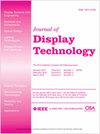Multi-SLM Color Holographic 3D Display Based on RGB Spatial Filter
Q Engineering
引用次数: 20
Abstract
A novel approach for color holographic 3D displays employing several liquid crystal based spatial light modulators (SLM) is presented. A multicolor reconstruction is introduced into circular monochrome display architecture with horizontal-only-parallax through the use of space-division method (SDM). In the SDM active area of an SLM is divided into three regions generating the RGB component images by using color spatial filter composed of a three glass stripes that are attached to the front of each SLM. Relatively low complexity level of SDM enables to upgrade a horizontal-only-parallax monochrome display to a color one at the expense of image resolution. There is no reduction of remaining key performance parameters, i.e., image dimensions, refresh frame rate, and viewing angle are preserved with no increase of SLM number. In this paper, practical aspects of color imaging implementation, including filter mask design and hardware calibration, are considered. Developed procedures focus on major three effects, i.e., spectral calibration of response of highly dispersive SLM phase, spatial calibration of filter mask and numerical alignment of RGB imaging volumes. The presented experimental results of static and dynamic 3D reconstructions of computer generated holograms validate the performance of calibration procedures and the high color imaging quality of the display.基于RGB空间滤波器的多SLM彩色全息3D显示器
提出了一种采用几种基于液晶的空间光调制器(SLM)的彩色全息3D显示器的新方法。利用空间分割法(SDM),将多色重建引入只有水平视差的圆形单色显示结构中。在SDM中,SLM的有源区域被划分为三个区域,通过使用由附着在每个SLM的前面的三个玻璃条纹组成的彩色空间滤波器来生成RGB分量图像。SDM相对较低的复杂度水平使得能够以牺牲图像分辨率为代价将仅水平视差单色显示器升级为彩色显示器。没有减少剩余的关键性能参数,即,在不增加SLM数量的情况下保留图像尺寸、刷新帧速率和视角。本文考虑了彩色成像实现的实际方面,包括滤光片掩模设计和硬件校准。开发的程序侧重于主要的三个效应,即高色散SLM相位响应的光谱校准、滤波器掩模的空间校准和RGB成像体积的数值对准。计算机生成全息图的静态和动态3D重建的实验结果验证了校准程序的性能和显示器的高彩色成像质量。
本文章由计算机程序翻译,如有差异,请以英文原文为准。
求助全文
约1分钟内获得全文
求助全文
来源期刊

Journal of Display Technology
工程技术-工程:电子与电气
CiteScore
1.50
自引率
0.00%
发文量
0
审稿时长
2.8 months
期刊介绍:
This publication covers the theory, material, design, fabrication, manufacturing and application of information displays and aspects of display technology that emphasize the progress in device engineering, design and simulation, materials, electronics, physics, and reliability aspects of displays and the application of displays. The Journal is sponsored by EDS, seven other IEEE societies (BT, CES, CPMT, IA, IM, PHO and SSC) and the Optical Society of America (OSA).
 求助内容:
求助内容: 应助结果提醒方式:
应助结果提醒方式:


